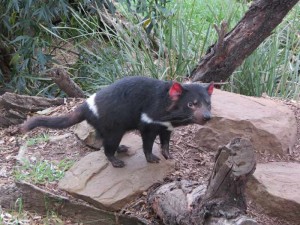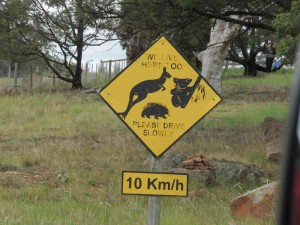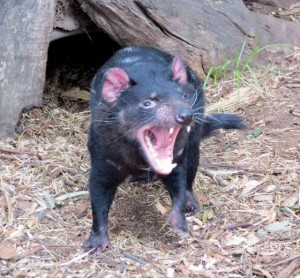A devil of a day
/I saw my first Tasmanian devil today. And I petted a wombat … and a koala.
 Australia has a slew of unique animals. There are ~200 species of just marsupials here that are found nowhere else in the world. Heck, there are over 60 species of kangaroos alone. Who would have thunk it? We've seen kangaroos, wallabies, koalas and wombats in the wild. But what about potoroos, pandemelons, bandicoots and quolls? I've never even heard of these critters. Have you? My spell checker certainly hasn't. And of course, we'd yet to encounter the famed, but elusive icon of Tasmania, a Tasmanian Devil (and I don't mean Looney Tunes' Taz).
Australia has a slew of unique animals. There are ~200 species of just marsupials here that are found nowhere else in the world. Heck, there are over 60 species of kangaroos alone. Who would have thunk it? We've seen kangaroos, wallabies, koalas and wombats in the wild. But what about potoroos, pandemelons, bandicoots and quolls? I've never even heard of these critters. Have you? My spell checker certainly hasn't. And of course, we'd yet to encounter the famed, but elusive icon of Tasmania, a Tasmanian Devil (and I don't mean Looney Tunes' Taz).
We're not much for zoos any more. We used to enjoy them with the kids, but in recent years, we prefer to see animals in the wild or if not, at least in a wide, open-space preserve. Friends recommended Bonorong Wildlife Sanctuary, not far from Hobart, to see some animals we might not otherwise get to observe. This facility is truly a sanctuary, dedicated to the preservation of native Tasmanian animals. They accept orphaned and injured animals, nurse them back to health and then release them into the wild again when and if practicable. When they can't be released, they've got a good home for life. They have an active breeding program for endangered species. In fact the name, Bonorong, is an aboriginal word meaning “native companion”.
 Bonorong is a pretty unpretentious place. It doesn't provide 4-color glossy brochures or classy souvenir ticket stubs when you pay your $24 entry fee. Instead, handlers, caretakers and volunteers share their time and expertise with the animals and with visitors as they stroll around. The place is clean and the animals look well-cared for … all there for nurturing or nursing. Tasmania, we're told, is the roadkill capital of the world. A small human population, but lots of fast-moving cars and a large nocturnal wildlife population account for 300,000 wildlife deaths per year. Remember the echidna in the middle of the road a couple of weeks ago?
Bonorong is a pretty unpretentious place. It doesn't provide 4-color glossy brochures or classy souvenir ticket stubs when you pay your $24 entry fee. Instead, handlers, caretakers and volunteers share their time and expertise with the animals and with visitors as they stroll around. The place is clean and the animals look well-cared for … all there for nurturing or nursing. Tasmania, we're told, is the roadkill capital of the world. A small human population, but lots of fast-moving cars and a large nocturnal wildlife population account for 300,000 wildlife deaths per year. Remember the echidna in the middle of the road a couple of weeks ago?
The chances of seeing a Tasmanian devil in the bush nowadays are very slim. A terrible contagious cancer known as DFTD (devil facial tumour disease) has decimated the population, leaving very few healthy devils in the wild. Additionally, they're pretty shy. They estimate that nearly 90% of the population has already succumbed to the disease and those left in the wild are obviously at high risk. They were placed on the endangered species list in 2008. The hope is that the healthy population can be repatriated to other disease-free areas and that Tasmanian devils will not go the way of the Tasmanian tiger.
 Devils received their name from early European explorers who heard blood-curdling screams outside their tents at night. The screams conjured up evil images … only a “devil” could sound like that. An interesting fact we learned is that the mother has between 20-40 joeys at a time … all about the size of a grain of rice. These miniscule devils fight their way out of the birth canal and into mom's pouch. The lucky four who attach to one of mom's four teats win the Darwinian race. Talk about a hard way to begin life. No wonder they have bad dispositions.
Devils received their name from early European explorers who heard blood-curdling screams outside their tents at night. The screams conjured up evil images … only a “devil” could sound like that. An interesting fact we learned is that the mother has between 20-40 joeys at a time … all about the size of a grain of rice. These miniscule devils fight their way out of the birth canal and into mom's pouch. The lucky four who attach to one of mom's four teats win the Darwinian race. Talk about a hard way to begin life. No wonder they have bad dispositions.
The devil-wrangler went to great lengths to explain how misunderstood these little guys are. This devil's name was Chompers. The handler coaxed him to climb a tree stump for a reward of a chicken neck which he quickly snatched … and then promptly tried to bite her foot.
Continued tomorrow...

